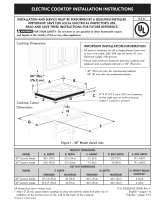
Notas importantes para el instalador
I. Lea todas las instrucciones contenidas en este manual
antes de instaJar el horno.
2.Saque todo el material usado en el embalaje del
compartimiento dei homo antes de conectar ei
suministro elSctrico o de gas a ia estufa.
3.Observe todos los c6digos y regiamentos pertinentes.
4.Deje estas instrucciones con ei consumidor.
5. La puerta del horno se puede retirar para facilitar la
instalaci6n.
6.ESTE HORNO NO ESTA APROBADO PARA LA
INSTALACI6N APILABLE O DE LADO A LADO.
Nora importante al consumidor
Conserve estas instrucciones y el manual del usuario para
referencia futura.
INSTRUCCIONES
IMPORTANTES DE SEGURIDAD
" Aseg_rese de que su homo de pared sea instalado y
puesto a tlerra de farina apraplada par un instalador
callflcado a par un t_cnlco de servlclo.
• Este homo de pared debe set el_ctrlcamenie puesto
a tlerra de acuerdo con los c6dlgos locales o, en su
ausencla, con el C6dlgo El_ctrlco Naclonal ANSI/
NFPA No. 70=Oltlma edlci6n en los Estadas Unldas, o
el C6dlgo El_ctrlco Canadlense CSA Standard C22.1,
Part 1, en Canad6.
Pisar, apoyarse, o sentarse sabre la
puerta de este homo de pared puede causar serlas
leslones y da_os al homo de pared.
• Nunca use su homo de pared para calentar una
habltaci6n. El usa prolongado de ia estufa sin ia
ventilaci6n adecuada puede ser peligroso.
La corrlente el_ctrlca al homo debe estar
apagada mlentras se hacen las conexlones de lineas. Si
no se apaga, da_os serlos o la muerte podrian resultar.
1. Carpinteria
Consulte la Figura 1o la figura 2 para conocer las di-
mensiones pertinentes al modelo de su homo y al espacio
necesario en el que poner el horno. La superficie donde
se va a apoyar el homo debe de ser de madera contra-
chapada s61ida u otro material similar y, sobre todo, la
superficie tiene que estar a nivel, de lado a lado, y de
atr6s hacia adelante.
2. Ajuste de la altura del homo
La altura del homo se puede ajustar con cu_as de madera de
2" (5 cm) de ancho, donde sea necesario, para que quepa en
un gabinete o abertura existente, cuando la altura del corte
es superior a 2713/16" (70,6 cm) en el caso del homo 0nico
de pared o 491,,_" (125.1 cm) en el caso del homo dobJe
de pared (ver la Figura 1 6 2). Colocar las cu_as de altura
apropiada debajo de los rieles laterales del horno.
3. Requerimientos El_ctricos
Se debe proveer el voltaje y la frecuencia apropiados a
este electrodom6stico, y conectarse a un circuito individual
correctamente puesto a tierra, protegido por un interruptor
o un fusible. Para conocer el interruptor o fusible que
requiere su modelo, vea la placa serial para encontrar
la consumaci6n del vatiaje y refierase al cuadro A para
encontrar el amperaje del interruptor o fusible.
Grados de
Vatios de!
electrodom_stico
240V
Menos de 4800W
4800W - 7200W
7200W - 9600W
9600W and +
Se recomienda Grados de I Se recomienda
Vnaprote_!_n Voti0_dej ' u,aprotecC!6n
a crc u !o e ec!r°d°m_st co a € rcut °
208V
20A Menos de 4100W 20A
30A 4100W - 6200W 30A
40A 6200W - 8300W 40A
50A 8300Wand+ 50A
Table A
Observe fodos los c6digos que gobiernan y ordenanzas locales
1. Un cable de 3 o 4 alambres monof6sico 120/240 o
120/208 voltios, 60 hertzios es la 0nica fuente el_ctrica
que requiere en un circuito separado en ambos lados de
la linea (alambre negro y alambre rojo) (se recomienda
un fusible o un interruptor de retraso de tiempo). No
funda a cable neutro (alambre blanco). Se debe de
tener precauci6n al combinar un horno de pared y una
cubierta, refi_rase a la placa de seria de cada uno de
los aparatos.
NOTA: Los tama_os y ias conexiones dei alambre deben
conformarse con el tama_o del fusible y el grado de la
aplicaci6n de acuerdo con el c6digo El_ctrico Nacional
Americano ANSI/NFPA No. 70- ultima edici6n, o con
el est6ndar CSA canadiense C22.1 , c6digo ei_ctrico
canadiense, parte 1, y c6digos y ordenanzas locales.
No se debera usar extenslones para
enchufar este electrodorn_stlcoo Esto podria causar un
incendlo, choque el_ctrlco u otto tlpo de da_o personal. Si
usted necesita un cable mas largo_ puede ordernar un cable
de 10" kit 903056-9010 Ilamando al centro de Servicio.
2. Este electrodom_stico debe conectarse a la caja de
fusibles (o de cortocircuito), por medio de un cable
blindado flexible o un cable con forro no met61ico. El
cable blindado flexible que va desde el electrodom_stico
debe de estar conectado directamente a la caja de
empalme. La caja de empalme debe de estar Iocalizada
en el lugar que se indica en la Figura 1 o 2, dejando
tanto exceso de cable como sea posible entre la caja y
el electrodom_stico, de forma que asi el electrodom_stico
se pueda mover f6cilmente, si fuera necesario para hacer
una reparaci6n.
3. Se debe de usar un conector que reduzca la tirantez de
una forma adecuada para unir el cable blindado flexible
a la caja de empalme.
11


















